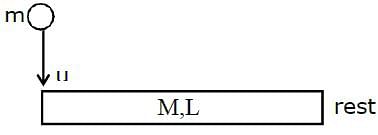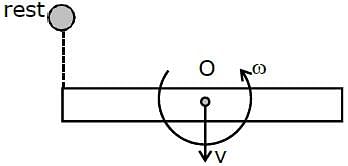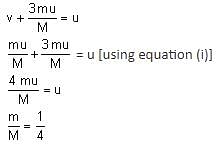JEE Exam > JEE Questions > A rod of mass M and length L is lying on a ho...
Start Learning for Free
A rod of mass M and length L is lying on a horizontal frictionless surface. A particle of mass 'm' travelling along the surface hits at one end of the rod with velocity 'u' in a direction perpendicular to the rod. The collision is completely elastic. After collision, particle comes to rest. The ratio of masses (m/M) is 1/x . The value of 'x' will be ____________.
Correct answer is '4'. Can you explain this answer?
| FREE This question is part of | Download PDF Attempt this Test |
Most Upvoted Answer
A rod of mass M and length L is lying on a horizontal frictionless sur...
Problem: Find the value of x where a particle of mass m collides with a rod of mass M and length L lying on a horizontal frictionless surface with velocity u in a direction perpendicular to the rod. The collision is completely elastic and after the collision, the particle comes to rest. The ratio of masses (m/M) is 1/x.
Solution:
Step 1: Analyzing the initial state
Before the collision, the particle of mass m is moving with a velocity u in a direction perpendicular to the rod. The rod of mass M and length L is lying on a horizontal frictionless surface at rest.
Step 2: Analyzing the collision
When the particle collides with the rod, it exerts a force on the rod. As the collision is completely elastic, the kinetic energy of the system is conserved. Therefore, the particle rebounds with the same velocity u in the opposite direction. By conservation of momentum, the rod acquires a velocity v in the same direction as that of the particle.
Step 3: Analyzing the final state
After the collision, the particle comes to rest and the rod is moving with a velocity v.
Step 4: Applying conservation of momentum
Before the collision, the momentum of the system was zero. After the collision, the momentum of the system is:
mv - M(0) = (m+M)v'
where v' is the velocity of the rod and particle after the collision.
Solving for v', we get:
v' = mv / (m+M)
Step 5: Applying conservation of energy
Before the collision, the kinetic energy of the system was:
(1/2)mu^2
After the collision, the kinetic energy of the system is:
(1/2)mv'^2 + (1/2)Mv'^2
Since the collision is completely elastic, the kinetic energy of the system is conserved. Therefore, we have:
(1/2)mu^2 = (1/2)(m+M)v'^2
Substituting the value of v', we get:
(1/2)mu^2 = (1/2)m^2v^2 / (m+M)^2 + (1/2)M^2v^2 / (m+M)^2
Simplifying, we get:
u^2 = v^2 / (m+M) + M^2v^2 / (m+M)^2
Step 6: Solving for x
Substituting the value of v' in terms of v, we get:
v^2 = 2mu^2 / (m+M)
Substituting this value in the previous equation, we get:
u^2 = 2mv^2 / (m+M) + 2Mv^2 / (m+M)
Simplifying, we get:
(m/M) = 3
Therefore, the value of x is:
x = 1 / (m/M) = 4
Hence, the value of x is 4.
Solution:
Step 1: Analyzing the initial state
Before the collision, the particle of mass m is moving with a velocity u in a direction perpendicular to the rod. The rod of mass M and length L is lying on a horizontal frictionless surface at rest.
Step 2: Analyzing the collision
When the particle collides with the rod, it exerts a force on the rod. As the collision is completely elastic, the kinetic energy of the system is conserved. Therefore, the particle rebounds with the same velocity u in the opposite direction. By conservation of momentum, the rod acquires a velocity v in the same direction as that of the particle.
Step 3: Analyzing the final state
After the collision, the particle comes to rest and the rod is moving with a velocity v.
Step 4: Applying conservation of momentum
Before the collision, the momentum of the system was zero. After the collision, the momentum of the system is:
mv - M(0) = (m+M)v'
where v' is the velocity of the rod and particle after the collision.
Solving for v', we get:
v' = mv / (m+M)
Step 5: Applying conservation of energy
Before the collision, the kinetic energy of the system was:
(1/2)mu^2
After the collision, the kinetic energy of the system is:
(1/2)mv'^2 + (1/2)Mv'^2
Since the collision is completely elastic, the kinetic energy of the system is conserved. Therefore, we have:
(1/2)mu^2 = (1/2)(m+M)v'^2
Substituting the value of v', we get:
(1/2)mu^2 = (1/2)m^2v^2 / (m+M)^2 + (1/2)M^2v^2 / (m+M)^2
Simplifying, we get:
u^2 = v^2 / (m+M) + M^2v^2 / (m+M)^2
Step 6: Solving for x
Substituting the value of v' in terms of v, we get:
v^2 = 2mu^2 / (m+M)
Substituting this value in the previous equation, we get:
u^2 = 2mv^2 / (m+M) + 2Mv^2 / (m+M)
Simplifying, we get:
(m/M) = 3
Therefore, the value of x is:
x = 1 / (m/M) = 4
Hence, the value of x is 4.
Free Test
FREE
| Start Free Test |
Community Answer
A rod of mass M and length L is lying on a horizontal frictionless sur...

Just before collision

Just after collision
From momentum conservation,

mu = Mv

From angular momentum conservation about O,

Coefficient of restitution = e = Relative velocity after collsion / Relative velocity before collision

From equations (ii) and (iii), we get

x = 4
Attention JEE Students!
To make sure you are not studying endlessly, EduRev has designed JEE study material, with Structured Courses, Videos, & Test Series. Plus get personalized analysis, doubt solving and improvement plans to achieve a great score in JEE.

|
Explore Courses for JEE exam
|

|
Similar JEE Doubts
A rod of mass M and length L is lying on a horizontal frictionless surface. A particle of mass m travelling along the surface hits at one end of the rod with velocity u in a direction perpendicular to the rod. The collision is completely elastic. After collision, particle comes to rest. The ratio of masses (m/M) is 1/x . The value of x will be ____________.Correct answer is '4'. Can you explain this answer?
Question Description
A rod of mass M and length L is lying on a horizontal frictionless surface. A particle of mass m travelling along the surface hits at one end of the rod with velocity u in a direction perpendicular to the rod. The collision is completely elastic. After collision, particle comes to rest. The ratio of masses (m/M) is 1/x . The value of x will be ____________.Correct answer is '4'. Can you explain this answer? for JEE 2024 is part of JEE preparation. The Question and answers have been prepared according to the JEE exam syllabus. Information about A rod of mass M and length L is lying on a horizontal frictionless surface. A particle of mass m travelling along the surface hits at one end of the rod with velocity u in a direction perpendicular to the rod. The collision is completely elastic. After collision, particle comes to rest. The ratio of masses (m/M) is 1/x . The value of x will be ____________.Correct answer is '4'. Can you explain this answer? covers all topics & solutions for JEE 2024 Exam. Find important definitions, questions, meanings, examples, exercises and tests below for A rod of mass M and length L is lying on a horizontal frictionless surface. A particle of mass m travelling along the surface hits at one end of the rod with velocity u in a direction perpendicular to the rod. The collision is completely elastic. After collision, particle comes to rest. The ratio of masses (m/M) is 1/x . The value of x will be ____________.Correct answer is '4'. Can you explain this answer?.
A rod of mass M and length L is lying on a horizontal frictionless surface. A particle of mass m travelling along the surface hits at one end of the rod with velocity u in a direction perpendicular to the rod. The collision is completely elastic. After collision, particle comes to rest. The ratio of masses (m/M) is 1/x . The value of x will be ____________.Correct answer is '4'. Can you explain this answer? for JEE 2024 is part of JEE preparation. The Question and answers have been prepared according to the JEE exam syllabus. Information about A rod of mass M and length L is lying on a horizontal frictionless surface. A particle of mass m travelling along the surface hits at one end of the rod with velocity u in a direction perpendicular to the rod. The collision is completely elastic. After collision, particle comes to rest. The ratio of masses (m/M) is 1/x . The value of x will be ____________.Correct answer is '4'. Can you explain this answer? covers all topics & solutions for JEE 2024 Exam. Find important definitions, questions, meanings, examples, exercises and tests below for A rod of mass M and length L is lying on a horizontal frictionless surface. A particle of mass m travelling along the surface hits at one end of the rod with velocity u in a direction perpendicular to the rod. The collision is completely elastic. After collision, particle comes to rest. The ratio of masses (m/M) is 1/x . The value of x will be ____________.Correct answer is '4'. Can you explain this answer?.
Solutions for A rod of mass M and length L is lying on a horizontal frictionless surface. A particle of mass m travelling along the surface hits at one end of the rod with velocity u in a direction perpendicular to the rod. The collision is completely elastic. After collision, particle comes to rest. The ratio of masses (m/M) is 1/x . The value of x will be ____________.Correct answer is '4'. Can you explain this answer? in English & in Hindi are available as part of our courses for JEE.
Download more important topics, notes, lectures and mock test series for JEE Exam by signing up for free.
Here you can find the meaning of A rod of mass M and length L is lying on a horizontal frictionless surface. A particle of mass m travelling along the surface hits at one end of the rod with velocity u in a direction perpendicular to the rod. The collision is completely elastic. After collision, particle comes to rest. The ratio of masses (m/M) is 1/x . The value of x will be ____________.Correct answer is '4'. Can you explain this answer? defined & explained in the simplest way possible. Besides giving the explanation of
A rod of mass M and length L is lying on a horizontal frictionless surface. A particle of mass m travelling along the surface hits at one end of the rod with velocity u in a direction perpendicular to the rod. The collision is completely elastic. After collision, particle comes to rest. The ratio of masses (m/M) is 1/x . The value of x will be ____________.Correct answer is '4'. Can you explain this answer?, a detailed solution for A rod of mass M and length L is lying on a horizontal frictionless surface. A particle of mass m travelling along the surface hits at one end of the rod with velocity u in a direction perpendicular to the rod. The collision is completely elastic. After collision, particle comes to rest. The ratio of masses (m/M) is 1/x . The value of x will be ____________.Correct answer is '4'. Can you explain this answer? has been provided alongside types of A rod of mass M and length L is lying on a horizontal frictionless surface. A particle of mass m travelling along the surface hits at one end of the rod with velocity u in a direction perpendicular to the rod. The collision is completely elastic. After collision, particle comes to rest. The ratio of masses (m/M) is 1/x . The value of x will be ____________.Correct answer is '4'. Can you explain this answer? theory, EduRev gives you an
ample number of questions to practice A rod of mass M and length L is lying on a horizontal frictionless surface. A particle of mass m travelling along the surface hits at one end of the rod with velocity u in a direction perpendicular to the rod. The collision is completely elastic. After collision, particle comes to rest. The ratio of masses (m/M) is 1/x . The value of x will be ____________.Correct answer is '4'. Can you explain this answer? tests, examples and also practice JEE tests.

|
Explore Courses for JEE exam
|

|
Suggested Free Tests
Signup for Free!
Signup to see your scores go up within 7 days! Learn & Practice with 1000+ FREE Notes, Videos & Tests.
























